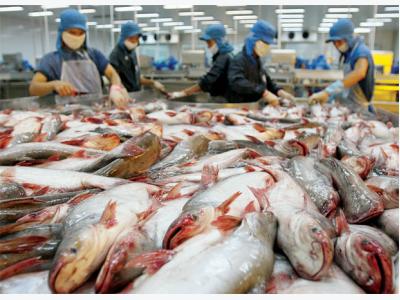Trade barriers may seriously affect Vietnams seafood industry

A number of seafood companies have been dissolved or have halted operation, while trade barriers from import countries are expected to.pose challenges to Vietnam’s fishery sector.
Thuan An, Hung Vuong, Camimex, Viet An, Phuong Nam, Binh An and Thien Ma, once famous names in the seafood sector, have been meeting with difficulties.
Thuan An still cannot pay bank debts, while the general director has disappeared. Hung Vuong, a big player in the industry, has unexpectedly reported a loss of VND49.3 billion, while Camimex has reported a loss of VND51 billion for 2016.
Meanwhile, Carrefour, the French retail group, has unexpectedly announced the stop of the sale of Vietnam’s catfish in Spain, Italy, France and other countries.
The decision was released after a Spanish TV channel gave false information about Vietnam’s catfish farmed in the Mekong River. They said the catfish were being bred in unclean cages and were not fed standard fish.
The EU’s import companies said that the catfish volume consumed by the retail group is inconsiderable. However, the secretary general of the Vietnam Association of Seafood Exporters and Producers (VASEP) said the media speaking ill of Vietnam’s catfish products has seriously affected the image and prestige of Vietnam’s catfish industry.
As such, Vietnamese exporters, who are worried about the effects of Brexit, have more reasons to worry about consumption of the EU market.
A number of seafood companies have been dissolved or have halted operation, while trade barriers from import countries are expected to.pose challenges to Vietnam’s fishery sector.
While the EU market imports will decline, bad news has come from the US which has applied a catfish monitoring program to Vietnamese catfish imports.
From September 2017, if export countries do not submit lists of export companies and documents to prove the national food hygiene programs as requested by FSIS (USDA Food Safety and Inspection Service), they won’t be able to export products to the US.
The strict requirement is believed to be a big barrier to Vietnam’s catfish entry into the market. Meanwhile, the US continues imposing anti-dumping duties on Vietnamese seafood companies in different periods.
Vinh Hoan Seafood does not bear anti-dumping duty, but it can anticipate big difficulties to be raised by the new law.
Therefore, the company has been trying to boost exports to both the EU and US markets, while actively conquering the Chinese market. However, 60 percent of the company’s output is still sold to the US.
Local newspapers reported that some Asian countries have been boosting their exports of tilapia and catfish into the US and Europe, which would affect Vietnam’s catfish exports.
Besides the four biggest catfish farming countries in Mekong River valley, including Thailand, Cambodia, Laos and Vietnam, some other SE Asian countries such as the Philippines and Indonesia have also expanded farming.
Related news
 Vietnam's $10 billion export target for shrimp
Vietnam's $10 billion export target for shrimp Vietnam's $10 billion export target for shrimp is ambitious but achievable.
 Up 7.9% in Vietnam shrimp exports to US
Up 7.9% in Vietnam shrimp exports to US The U.S. remains to be the largest market of Vietnamese shrimp, making up 22.5% of total shrimp exports in 2016
 White-leg shrimp farming’s profits lower than tiger prawn
White-leg shrimp farming’s profits lower than tiger prawn The cost of raising white-leg shrimp under the extensive farming pilot model is up to 13.5 million VND (590 USD) per hectare in Cuu Long (Mekong) Delta province